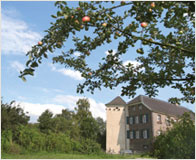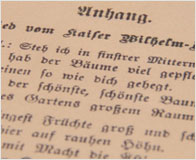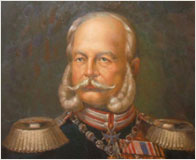- ι
- ι
- ι
- ι
- ι
- ι
- Visitor Information
- ι
Kaiser Wilhelm Apple - The emperor's new apple
I'm a direct descendant of the original Kaiser Wilhelm apple tree. The schoolteacher and pomologist Carl Hesselmann first discovered my ancestor quite nearby in the orchard of Haus Bürgel in 1864.



My apples are very large and tasty and have an attractive colour. Their splendid appearance moved Herr Hesselmann to write a letter to the German emperor, "most humbly" asking whether my ancestor might bear his majesty's name. Having tasted one of the apples, Wilhelm I graciously let it be known (through one of his court officials, Fürst Pückler) that he was agreeable. I'm rather proud of that.
Truly royal?
Discovery
The schoolteacher and pomologist Carl Hesselmann originally hailed from the Bergisches Land, but it was here in the orchard at Haus Bürgel that he first discovered an unknown apple cultivar. Its fruit were large, tasty, and red, so it was probably related to the Renette apple.
Ennoblement
Hesselmann sent a few samples to Berlin and "most humbly" solicited permission to name the new cultivar after Kaiser Wilhelm. The emperor graciously conferred his approval (through one of his court officials, Fürst Pückler). The noble cultivar soon became popular all over Germany.
Peter after all
In the 1930s a number of pomologists noticed a remarkable similarity between the Kaiser Wilhelm apple and an older, regional apple cultivar. In 2011 genetic testing ascertained that Hesselmann's proud new discovery was really an old-established cultivar called Peter Broich.
Since that time, the Kaiser Wilhelm apple tree may be found in orchards all over Germany – and of course here in its old home in the Urdenbacher Kämpe, too.
back
Truly royal?
Discovery
The schoolteacher and pomologist Carl Hesselmann originally hailed from the Bergisches Land, but it was here in the orchard at Haus Bürgel that he first discovered an unknown apple cultivar. Its fruit were large, tasty, and red, so it was probably related to the Renette apple.
Ennoblement
Hesselmann sent a few samples to Berlin and "most humbly" solicited permission to name the new cultivar after Kaiser Wilhelm. The emperor graciously conferred his approval (through one of his court officials, Fürst Pückler). The noble cultivar soon became popular all over Germany.
Peter after all
In the 1930s a number of pomologists noticed a remarkable similarity between the Kaiser Wilhelm apple and an older, regional apple cultivar. In 2011 genetic testing ascertained that Hesselmann's proud new discovery was really an old-established cultivar called Peter Broich.
Since that time, the Kaiser Wilhelm apple tree may be found in orchards all over Germany – and of course here in its old home in the Urdenbacher Kämpe, too.
Search:






